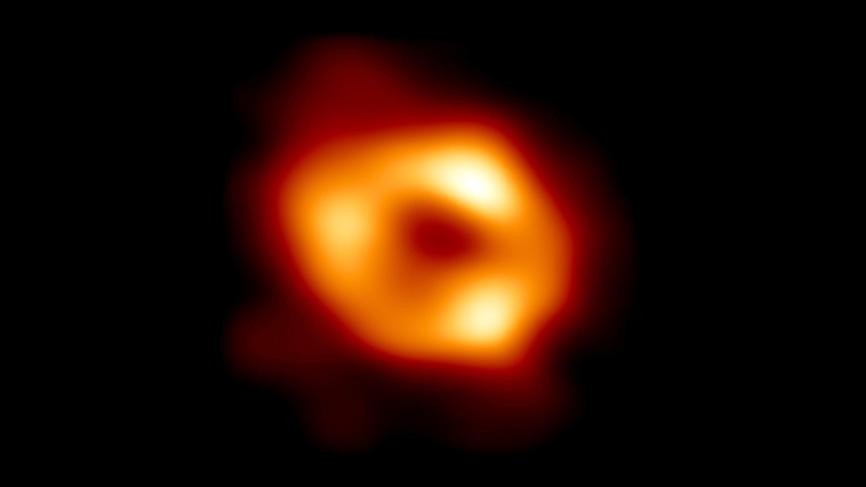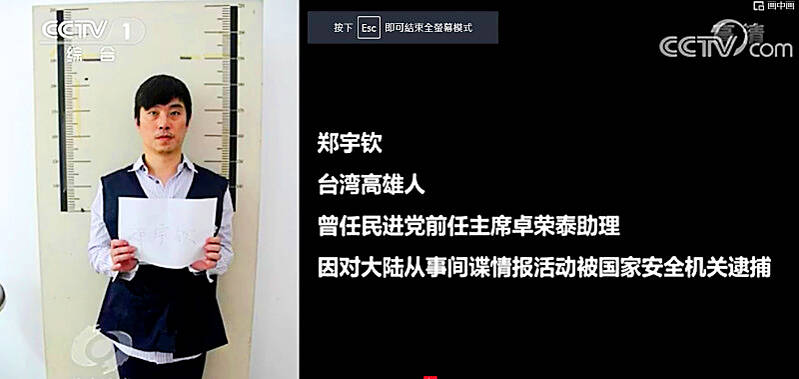An international astronomical project that includes Taiwan’s Academia Sinica on Thursday released the first-ever image documenting the existence of a massive black hole at the center of the Milky Way.
Astronomers believe nearly all galaxies have giant black holes at their bustling and crowded center, where light and matter cannot escape, making it extremely hard to capture images of them. Light is bent and twisted around by gravity, as it is sucked into the abyss, along with superheated gas and dust.
The colorized image unveiled on Thursday is from an international consortium comprising 13 research units from around the world. The Event Horizon Telescope (EHT), a collection of eight synchronized radio telescopes around the world, captured the image of Sagittarius A*, a black hole at the center of our galaxy about 27,000 light years away.

Photo: Reuters / EHT Collaboration /National Science Foundation
University of Arizona astrophysics professor Feryal Ozel described it as a “gentle giant” while announcing the breakthrough along with other astronomers involved in the project.
Academia Sinica President James Liao (廖俊智) told a press conference held simultaneously in Taipei that the image offered direct proof of earlier scientific work that provided evidence of a black hole at the center of our galaxy.
“With Academia Sinica as one of the 13 members of the EHT, we have again shown Taiwan’s continued role in the world’s most important scientific discoveries,” he added.
The picture also confirms Albert Einstein’s general theory of relativity: The black hole is precisely the size that Einstein’s equations dictate. It is about the size of the orbit of Mercury around the sun.
Black holes gobble up galactic material, but Ozel said this one is “eating very little.”
It is equivalent to a person eating a single grain of rice over millions of years, another astronomer said.
University of California, Los Angeles astronomy professor Andrea Ghez, not part of the telescope team, but who earned a Nobel Prize for the discovery of the Milky Way’s black hole in the 1990s, said the image of “my baby” is exactly how it should be — an eerie-looking orange-red ring with utter blackness in the middle.
Scientists had expected the Milky Way’s black hole to be more violent, especially since the only other image from another galaxy shows a far bigger and more active black hole.
“It is the cowardly lion of black holes,” said Event Horizon Telescope project scientist Geoffrey Bower, a research fellow at Academia Sinica’s Institute of Astronomy and Astrophysics.
Because the black hole “is on a starvation diet,” little material is falling into the center, and that allows astronomers to gaze deeper, he said.
The Milky Way black hole is probably more typical of what is at the center of most galaxies, “just sitting there doing very little,” he added.
It is incredibly hot, trillions of degrees, Ozel said.
The same telescope group released the first black hole image in 2019. The picture was from a galaxy 53 million light years away that is 1,500 times bigger than the one in our galaxy.
To get the picture, the eight telescopes had to coordinate closely “in a process similar to everyone shaking hands with everyone else in the room,” said astronomer Vincent Fish of the Massachusetts Institute of Technology.
Astronomers worked with data collected in 2017 to get the new images. The next step is a movie of one of those two black holes, maybe both, Fish said.
The project cost nearly US$60 million, with US$28 million coming from the US National Science Foundation.
The research results were published in the latest edition of The Astrophysical Journal Letters.
The EHT project, established in 2017, is a global network of radio telescopes — including the Greenland Telescope, the Submillimeter Array (SMA) in Hawaii and the ALMA telescope in Chile — which function together as one large telescope.
Academia Sinica scientists assist in the operation of the project’s telescopes, as well as in image processing and the development of computer simulations.
Additional reporting by CNA

Former Czech Republic-based Taiwanese researcher Cheng Yu-chin (鄭宇欽) has been sentenced to seven years in prison on espionage-related charges, China’s Ministry of State Security announced yesterday. China said Cheng was a spy for Taiwan who “masqueraded as a professor” and that he was previously an assistant to former Cabinet secretary-general Cho Jung-tai (卓榮泰). President-elect William Lai (賴清德) on Wednesday last week announced Cho would be his premier when Lai is inaugurated next month. Today is China’s “National Security Education Day.” The Chinese ministry yesterday released a video online showing arrests over the past 10 years of people alleged to be

THE HAWAII FACTOR: While a 1965 opinion said an attack on Hawaii would not trigger Article 5, the text of the treaty suggests the state is covered, the report says NATO could be drawn into a conflict in the Taiwan Strait if Chinese forces attacked the US mainland or Hawaii, a NATO Defense College report published on Monday says. The report, written by James Lee, an assistant research fellow at Academia Sinica’s Institute of European and American Studies, states that under certain conditions a Taiwan contingency could trigger Article 5 of NATO, under which an attack against any member of the alliance is considered an attack against all members, necessitating a response. Article 6 of the North Atlantic Treaty specifies that an armed attack in the territory of any member in Europe,

LIKE FAMILY: People now treat dogs and cats as family members. They receive the same medical treatments and tests as humans do, a veterinary association official said The number of pet dogs and cats in Taiwan has officially outnumbered the number of human newborns last year, data from the Ministry of Agriculture’s pet registration information system showed. As of last year, Taiwan had 94,544 registered pet dogs and 137,652 pet cats, the data showed. By contrast, 135,571 babies were born last year. Demand for medical care for pet animals has also risen. As of Feb. 29, there were 5,773 veterinarians in Taiwan, 3,993 of whom were for pet animals, statistics from the Animal and Plant Health Inspection Agency showed. In 2022, the nation had 3,077 pediatricians. As of last

XINJIANG: Officials are conducting a report into amending an existing law or to enact a special law to prohibit goods using forced labor Taiwan is mulling an amendment prohibiting the importation of goods using forced labor, similar to the Uyghur Forced Labor Prevention Act (UFLPA) passed by the US Congress in 2021 that imposed limits on goods produced using forced labor in China’s Xinjiang region. A government official who wished to remain anonymous said yesterday that as the US customs law explicitly prohibits the importation of goods made using forced labor, in 2021 it passed the specialized UFLPA to limit the importation of cotton and other goods from China’s Xinjiang Uyghur region. Taiwan does not have the legal basis to prohibit the importation of goods